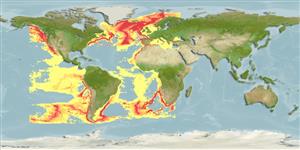|
Pectinida |
Pectinidae
Environment: milieu / climate zone / depth range / distribution range
Ecologia
Associadas(os) a recifes; intervalo de profundidade 27 - 4312 m (Ref. 105406). Subtropical; 75°N - 58°S, 145°W - 36°E
Eastern Pacific, Atlantic Ocean, Mediterranean Sea to the Arctic: Western to northern Europe, and Western Africa.
Length at first maturity / Tamanho / Peso / Idade
Maturity: Lm ? range ? - ? cm Max length : 2.0 cm SHH macho/indeterminado; (Ref. 90120)
Inhabits deep-water coral reef mound (Ref. 105183). It is also found in sublittoral to abyssal depths, usually attached to rocks, stones, gorgonians, or hydroids on muddy and sandy substrates (Ref. 90120). Epibionts on the trunk of the black coral Leiopathes glaberrima bush (Ref. 105183). Colonized by the parasitic foraminifer Hyrrokkin sarcophaga (Ref. 105186). Suspension feeder (Ref. 105183). In general, suspension feeding bivalves mainly depend on phytoplankton and detritus material for nutrition (Ref. 107088).
Life cycle and mating behavior
Maturidade | Reprodução | Desova | Ovos | Fecundidade | Larvas
Members of the class Bivalvia are mostly gonochoric, some are protandric hermaphrodites. Life cycle: Embryos develop into free-swimming trocophore larvae, succeeded by the bivalve veliger, resembling a miniature clam.
Demir, M. 2003. (Ref. 2754)
Categoria na Lista Vermelha da IUCN (Ref. 130435)
Categoria CITES (Ref. 108899)
Not Evaluated
Not Evaluated
Ameaça para o homem
Utilização humana
| FishSource |
Ferramentas
Mais informação
Idade/Tamanho
Crescimento
Comprimento-peso
Comprimento-comprimento
Morfologia
Larvas
Abundância
Fontes da internet
Estimates based on models
Preferred temperature
(Ref.
115969): 2.6 - 8.7, mean 4 (based on 528 cells).
